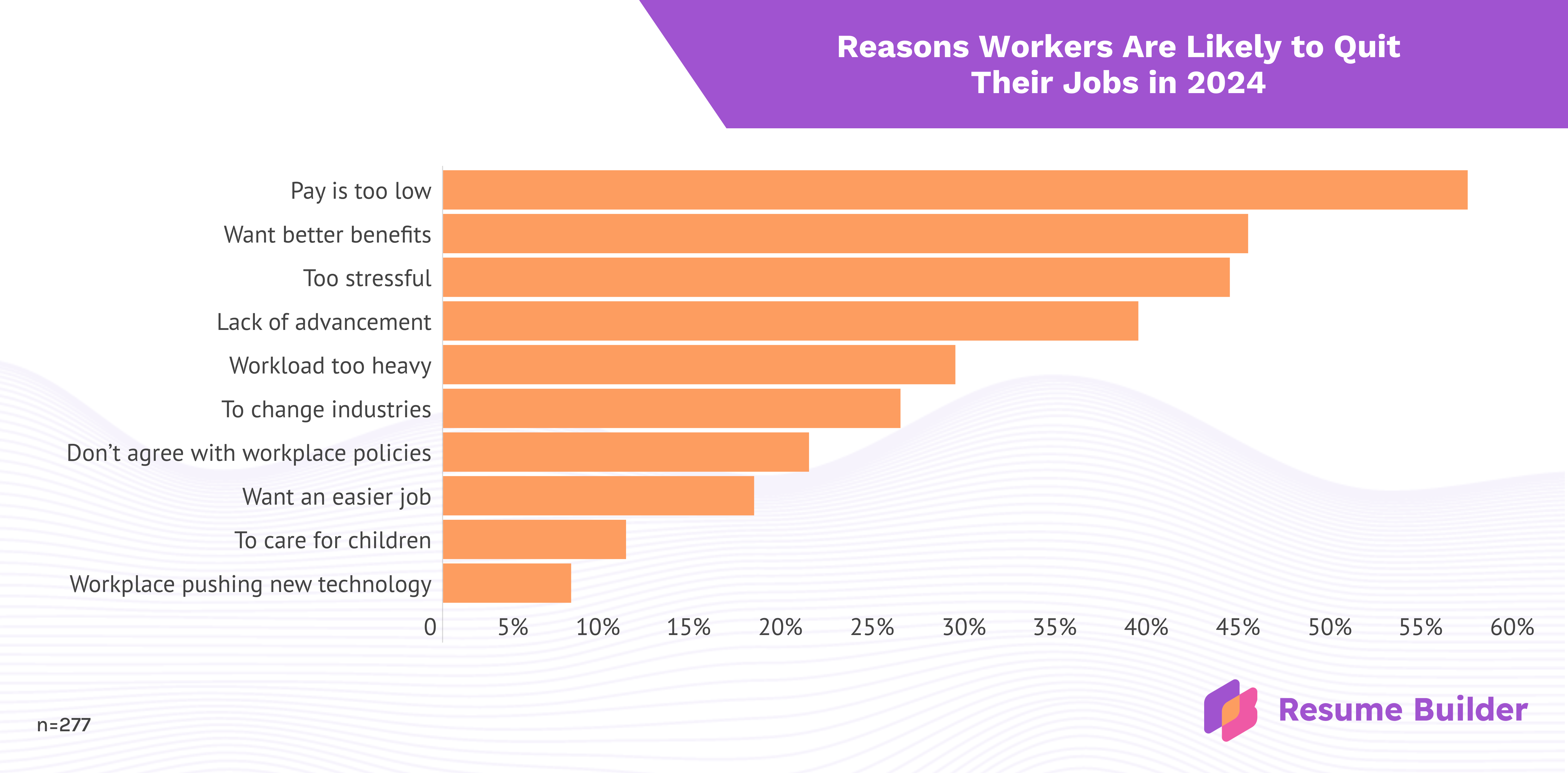Back in 2021 and 2022 the workforce went through something called, “The Great Resignation”. Due to changes in working conditions caused by the global pandemic, workers quit their jobs in record numbers. At that time, 72% of tech workers thought about quitting their job and they did. In 2024, while the Great Resignation has slowed down, it has not stopped completely.
The software development industry is on track to lose four million developers by 2025, and this comes at a time when the total number of software development jobs available are ready to hit 85.2 million by 2030. If these predictions continue to be true, by 2030, the global developer recession could result in businesses losing $8.5 trillion in annual revenue. Facing this growing talent shortage, this article outlines the key reasons developer resignations are remaining high. In addition, we will look at modern hiring and retention tactics businesses can use to develop and maintain their talent pool.
Why So Many Resignations?
There are a myraid of reasons why a software developer chooses to leave their job or the industry altogether. A recent survey from ResumeBuilder.com asked why workers were planning to quit their jobs this year. The most common reasons respondents selected included low pay (56%), desire for better benefits (44%), and overly stressful work (43%).

These sentiments carry over to software developers.
1. Inadequate Compensation: While salary is not the sole motivator, competitive compensation is crucial for retaining talent. Inadequately compensated developers leave to find an employer that puts greater value on their skills and contributions.
2. Burnout: Software development is intense, with long hours, tight deadlines, and constant pressure to deliver. Burnout results from prolonged periods of stress and overwork. A toxic work environment, characterized by issues such as unclear expectations, or ineffective communication, can speed up a developer’s burnout.
3. Lack of Growth Opportunities: Developers thrive on learning and professional growth. When there are limited opportunities for skill development, career advancement, or challenging projects using modern technologies, developers feel stagnant and seek opportunities. Developers who do not receive recognition for their work feel unappreciated and undervalued, leading to job dissatisfaction.
4. Work-Life Balance Issues: Despite the flexibility often associated with tech jobs, developers struggle with maintaining a healthy work-life balance due to demanding project schedules or a culture that encourages overtime.
5. Poor Management: Effective management is crucial for fostering a positive work environment and supporting team morale. Poor management practices, such as lack of clear direction, micromanagement, or favoritism, drive developers to seek better leadership. For organization struggling with micromanagement, I encourage you to read, “Management vs. Micromanagement”.
Understanding why developers quit helps companies improve their employee retention strategies and gives indications of what job seekers are looking for. This leads to more enticing job listings, better recruitment funnels, and better talent for the organization.
Hiring Post Pandemic

"Great vision without great people is irrelevant."
Even before the pandemic, technical job vacancies took 50% more time to fill in comparison to other roles, an average of 66 days. 64% of executives say that talent shortages are the most significant barrier to adopt emerging technologies into their business. These tailored suggestions aim to help businesses improve their hiring process to reduce the time it takes to fill vacancies.
1. Expanding Talent Pools: Companies need to take advantage of the diverse global IT talent pool. Improving job descriptions to be more inclusive for women, remote workers, people of color, people with disabilities, and other marginalized factions increases the total number of candidates available. This includes a greater focus on outsourcing work to explore talent pools in new geographies.
Here at ACV, this has inspired us to create a development center in Chennai, India with tremendous recruiting and hiring results.
2. Look for Skills, Not Degrees: Having degree requirements is becoming an outdated measure for candidate fit. At the height of the Great Resignation, companies focused on skills-based hiring in place of four-year-degrees. It is also worth noting that 87% of all developers, say they have taught themselves a new language, framework, or tool outside of their formal education. This means that even if a company insists that their tech talent has a degree, they cannot guarantee that the skills that degree taught are still relevant. Hiring managers should look for candidates who have skills that fit the position and the ability to learn new skills independently.

3. Embrace Hybrid and Remote Work: Remote working has changed the hiring landscape by expanding it globally. Folks looking for better work-life balance see remote work as an additional benefit. Businesses should strive to create a work environment that supports hybrid or fully remote positions, and then leverage this ability to make job postings more attractive to job seekers.
4. Reconsider Salary Bands: Proper compensation packages are the greatest indicator of how easy it will be to fill an empty position. Even when compared to remote work, compensation still dominates most negotiations. Consider that in a recent survey from Talent IMS, 62% of survey respondents indicated that they would not accept a 10% pay cut to work from home permanently. Software developers continue to prioritize, above everything else, fair trade between the value they provide and the benefits they receive. It is worth noting that compensation packages can and should include learning and development opportunities.
5. Speed Up the Hiring Process: Slow recruitment is a major detriment to a company’s hiring strategy. While companies wait to decide, a good software developer already starts looking for better opportunities. Multiple rounds of interviews, take-home coding projects, and delayed feedback all try a candidate’s patience and make them question if the job is worth it. Businesses benefit the most by keeping the hiring process streamlined and getting feedback to the candidate as quickly as possible.
Retaining Talent Post Pandemic
 Richard Branson
Richard Branson
"Take care of your employees and they'll take care of your business."
With the increase of remote work in the tech industry, hiring and retaining talent has become more challenging. There are more geographic flexible opportunities available to software developers. Based on why so many developers quit, it becomes clear that retaining software developers involves creating an environment where they feel valued, challenged, and supported. These strategies help retain software developers:
1. Competitive Compensation: Companines should strive to offer competitive salaries and benefits packages that align with industry standards. As a recent Stack Overflow survey phrased it, “Learning is great, but earning is better.” This includes benefits like health insurance, retirement plans, flexible work arrangements, and bonuses or profit-sharing programs.
2. Professional Development Opportunities: Companies should offer opportunities for continuous learning and skill development. A highly educated staff will be more productive and efficient. Developers will feel less stressed as well. The need to stay on top of the newest technologies is one of the main contributors to developer burnout. By offering opportunities for skill development, companies can relieve stress from developers. Business should encourage developers to attend conferences, workshops, and courses relevant to their roles.
At ACV developers are encouraged to attend conferences like Connect Tech, Collision, and Code Mash. In addition, developers can take classes and earn certifications through Plural Sight and Cornell.
3. Create a Positive Work Environment: Companies should foster a culture of respect, open communication, and collaboration. Managers should encourage teamwork and recognize individual and team achievements.
ACV created an appreciation program called, “Pace Car.” The program allows anyone to recognize the hard work and contribution of anyone else in the organization through a Slack message. During our monthly org. meetings, we then read Pace Cars aloud for everyone to hear.
4. Provide Work-Life Balance: Organizations need to respect work-life balance by promoting reasonable working hours and minimizing overtime. If the business’s products require an on-call rotation for support, the balanced rotation should contain enough participating members to make an on-call shift infrequent. Businesses should support initiatives that promote mental health and well-being.
At ACV we celebrate World Mental Health Day, offer private team meditations, and have a flexible vacation policy to help ensure that our software developers can unplug when they need to.
5. Supportive Leadership and Management: Poor management leads to software developer resignations, so it is important to train managers to effectively support their teams. To create the positive work environment mentioned earlier, managers need encouragement to have transparent communication, regular check-ins, and mentorship. Middle managers should not assume everyone has the required skills to make these actions effective and plan training in accordance. Managers who feel supported and cared for end up being better advocates for their team members’ needs and career growth.
What about AI?
AI will help the talent shortage by making developers more efficient. A recent Pluralsight AI skills report indicates that 81% of executives have deployed or will deploy AI tools and technologies. The companies that have deployed this tech are already seeing an 18% increase in productivity and efficiency. In time, a single developer will be able to do the work of two or three developers.

But before we get too excited about how AI might help alleviate this problem, there are a few data points we need to take into consideration.
1. Training Required: The same Pluralsight AI report goes on to point out that while 81% of IT professionals feel confident that they can work with AI, only 12% have experience doing it. This is another indication that on-the-job training is important for hiring and retaining workers. Higher education facilities also do not have a standard AI curriculum, meaning that businesses need a support plan in place to help their employees acquire these new skills.
2. Quality Assurance: AI generated code can contain security vulnerabilities that are not immediately apparent. If a developer uses AI generated code they do not fully understand, defect risks increase. Like any innovative technology, even the AI itself can contain bugs. Businesses will want to weigh the risks of relying on recent technology that does not have a robust support community in place.
3. Intellectual Property Issues: Depending on how businesses want to leverage AI, there are code originality, ownership, and attribution concerns to consider. For example, AI that helps developers write code may have trained on proprietary software. Who gets credit for the code the AI writes? Is it the developer using the AI, the company that owns the AI, or the company who owns the software the AI trained on? Businesses will want to consider if there are any conflicts between using AI technologies developed under questionable means and their own corporate values.
When it comes to AI, it is important to remember that a company’s strategic advantages do not come from technology. When everyone is using or offering AI products, it will not be an advantage, it will just be a qualifier. True strategic advantage comes from the talent the organization hires and retains.
Growing Together
Facing a talent shortage is always a daunting task compounded by a workforce that looks and acts quite differently after the global pandemic. Software developers have more opportunities for better compensation, faster career growth, and unprecedented work-life balance. Companies that are growing their staff and retaining their hard-earned talent need to make sure that they treat their developers fairly, give learning opportunities through challenging projects with modern technologies, and support their developers through leadership and management best practices. Managers that strive to make the best work environment possible for software developers will win the talent war and will leave the tech industry in a much better place.














